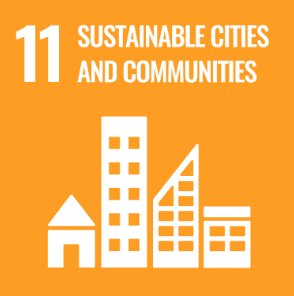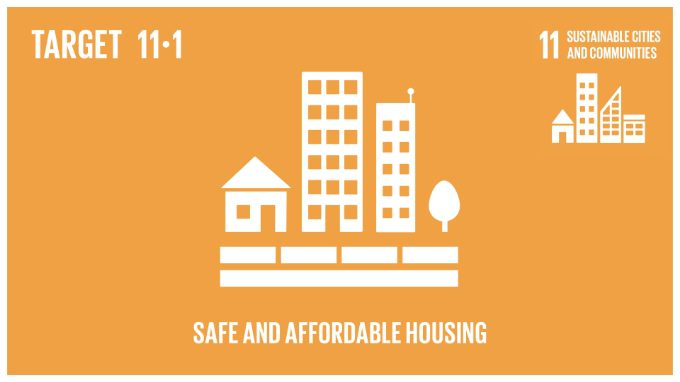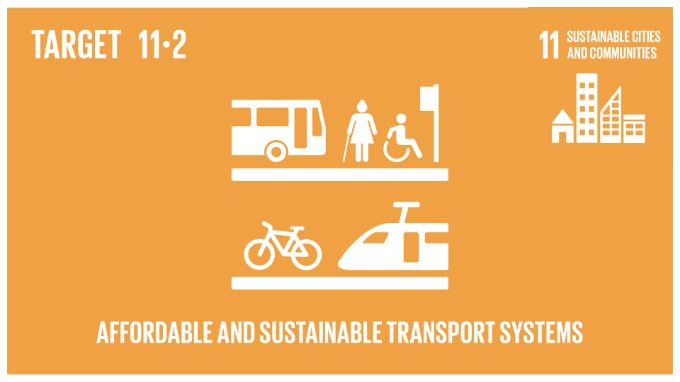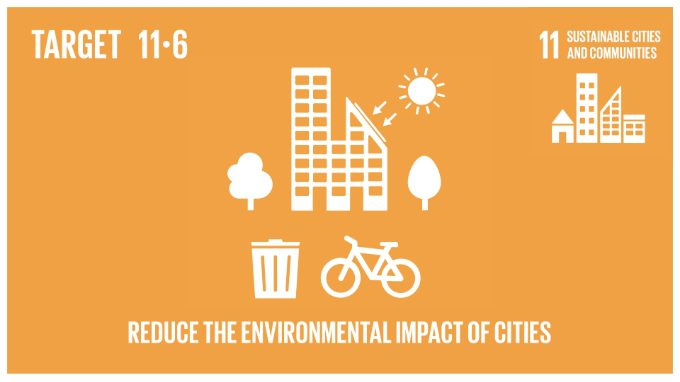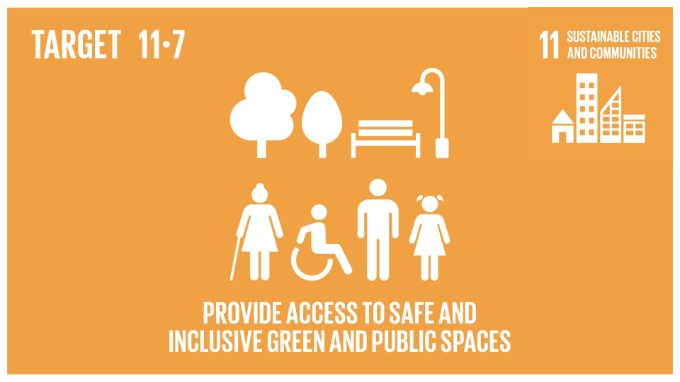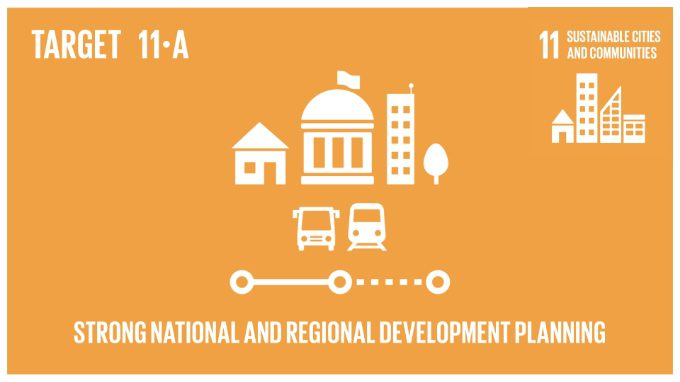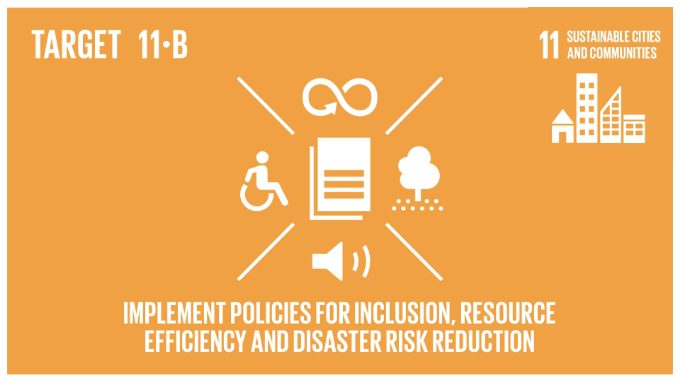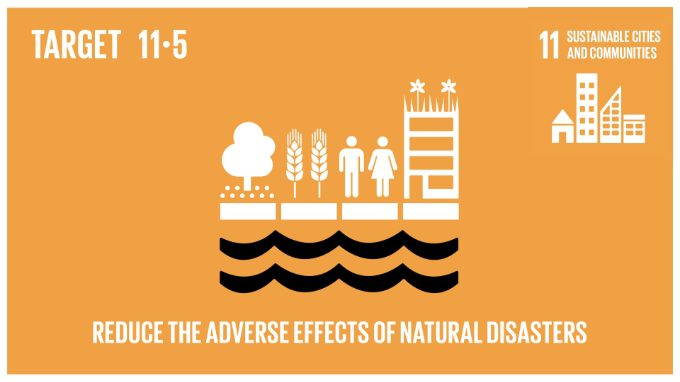Overview:
The world’s population is constantly increasing.To accommodate everyone, we need to build modern, sustainable cities. For all of us to survive and prosper, we need new, intelligent urban planning that creates safe, affordable and resilient cities with green and culturally inspiring living conditions.

International Progress 2023:
The pandemic has caused major shifts in migration patterns, including huge movements of people in and out of urban areas. Furthermore, climate change and conflicts tend to have disproportionate impacts on cities. These factors mean that the world is far from achieving the goal of sustainable cities.
In many developing countries, slum populations have been growing, putting at risk the target of adequate housing for all by 2030. Since 2015, the number of countries with national disaster risk reduction strategies has more than doubled. To achieve SDG 11, efforts must focus on strengthening capacities for planning for urban development, improving access to public transportation and enhancing waste management.
Targets —
-

Target 11.1
As of 2022, nearly 1.1 billion people lived in slums or slum-like conditions in urban areas, with an additional 2 billion expected to live in slums or slum-like conditions over the next 30 years. The growing number of slum population is a manifestation of the housing crisis, a situation in many instances that has now been exacerbated by the impacts of the COVID-19 pandemic.
-

Target 11.2
According to 2022 data from 1507 cities in 126 countries, only 51.6% of the world’s urban population has convenient access to public transport, with considerable variations across regions.
-

Target 11.3
According to data compiled from 815 cities for the period 1990 – 2020, the physical expansion of cities globally was faster than the rates of population growth. For the 2000-2010 period, the average annual land consumption rate was 2.0%, while the population growth rate averaged 1.4%. These rates declined to 1.5% and 0.6% respectively for the period 2010-2020.
-

Target 11.6
In 2022, the global average municipal solid waste (MSW) collection rate in cities was at 82%, and the average MSW managed in controlled facilities in cities was 55%. The MSW collection rates in sub-Saharan Africa and Oceania are less than 60%. Uncollected waste is the source of plastic pollution, GHG emissions, and sources of incubation for infections.
-

Target 11.7
Data for 2020 from 1,072 cities in 120 countries indicate that more than three-quarters of these cities have less than 20% of their area dedicated to open public spaces and streets, about half of the proportion recommended. On average, open public spaces account for a meagre 3.2% of urban land, about 4 times less than the share of land in streets.
-

Target 11.a
According to a 2021 assessment on compliance of the 58 National Urban Policies, 55 (95%) fulfilled the first criterion on “responding to population dynamics”, 54 (93%) fulfilled the second criterion on “ensuring balanced territorial development” and only 26 (45%) met the third criterion on making considerations for “increased local fiscal space”, which calls for setting up more financing mechanisms for local implementation of sustainable urban development.
-

Target 11.b
By the end of 2022, 102 countries reported having local governments with disaster risk reduction strategies, an increase from 51 countries in 2015.
Ireland’s
Progress 2023:
Ireland has not reached 100% of the population using at least basic sanitation services and having basic drinking water services. Many of our imports contribute to water scarcity. In Ireland all water policy and management is guided by the Water Framework Directive. Under this directive Ireland has been set a target of achieving at least ‘good status’ for all waters in the country, along with no deterioration. Despite a lot of good work over the last 20-30 years we are falling short in achieving this target and water quality has declined in recent years.
The water quality at half (50%) of the monitored river water bodies in Ireland is categorised as being at ‘good’ and ‘high’ ecological status. The remaining half are at less than good (50%). Almost one fifth (18.5%) of monitored river water bodies are in poor or bad status and are severely polluted. The key issue is eutrophication, driven by excess phosphorus in freshwaters and excess nitrogen in estuarine and marine waters. Changes to the physical habitat including excess sediment (hydro morphology) are the next biggest issue. Agriculture is the most significant pressure, followed by urban discharges, channel maintenance and other physical habitat changes, forestry, peat cutting and domestic wastewater. Diffuse pollution is widespread and presents the greatest challenge. At the current level of progress, Ireland will fail to meet the EU and national goal of restoring all waters to good or better status by 2027. In 2022, 3 bathing waters were classified as ‘Poor’, up from two in 2021.
Targets —
-

By 2030, ensure access for all to adequate, safe and affordable housing and basic services and upgrade slums.
CSO data
Status: There are challenges in housing certain communities
11.1.1 According to the Census of Population only 1.4% of households had no central heating in 2016. There were 8,914 people (6,463 adults and 2,451 children) homeless and living in emergency accommodation in December 2021, an increase of 8.7% from December 2020.
11.1.1
Proportion of urban population living in slums, informal settlements or inadequate housing
-

By 2030, provide access to safe, affordable, accessible and sustainable transport systems for all, improving road safety, notably by expanding public transport, with special attention to the needs of those in vulnerable situations, women, children, persons with disabilities and older persons.
CSO data
Claim: Achieving
11.2.1 For 4.4 million people, (93% of the population), the bus stop was the nearest public transport option. A train station was the closest public transport option for 253,462 people (5.3%), while a Luas station was the nearest public stop for 30,871 people (0.6%). This is not disaggregated by sex, age and persons with disabilities.
11.2.1
Proportion of the population that has convenient access to public transport, by sex, age and persons with disabilities
-

By 2030, enhance inclusive and sustainable urbanization and capacity for participatory, integrated and sustainable human settlement planning and management in all countries.
CSO data
Status: Land consumption increasing
11.3.1. Artificial surface cover increased by just over 10% between 2015 and 2018, compared with a population increase of 3.6%.
11.3.2 The Department of Housing, Local Government and Heritage, on behalf of the Government has prepared and published the finalised National Planning Framework under Project Ireland 2040, the overarching policy and planning framework for the social, economic, and cultural development of our country.
11.3.1
Ratio of land consumption rate to population growth rate
11.3.2
Proportion of cities with a direct participation structure of civil society in urban planning and management that operate regularly and democratically
-

Strengthen efforts to protect and safeguard the world’s cultural and natural heritage.
CSO data
Claim: Achieving
11.4.1 Heritage budget of €165.8 million allocated in 2022.
11.4.1
Total per capita expenditure on the preservation, protection and conservation of all cultural and natural heritage, by source of funding (public, private), type of heritage (cultural, natural) and level of government (national, regional, and local/municipal)
-

By 2030, significantly reduce the number of deaths and the number of people affected and substantially decrease the economic losses relative to gross domestic product caused by disasters, including water-related disasters, with a focus on protecting the poor and people in vulnerable situations.
CSO data
Claim: Achieving
11.5.1 Ireland participated in the Sendai Framework Data Readiness Review 2017.
11.5.2 Ireland participated in the Sendai Framework Data Readiness Review 2017.
11.5.1
Number of deaths, missing persons and directly affected persons attributed to disasters per 100,000 population
11.5.2
Direct economic loss in relation to global GDP, damage to critical infrastructure and number
of disruptions to basic services, attributed to disasters -

By 2030, reduce the adverse per capita environmental impact of cities, including by paying special attention to air quality and municipal and other waste management.
CSO data
Status: Municipal waste increasing
11.6.1 1.573 million tonnes of household waste were managed in Ireland in 2019. This is a 3% increase since 2018. Managed waste is waste that is collected from households or brought to waste collection centres.
11.6.2 Overall a World Health Organisation (WHO) air quality guideline for PM (PM10 or PM2.5) was exceeded at a total of 38 monitoring stations.
11.6.1
Proportion of municipal solid waste collected and managed in controlled facilities out of total municipal waste generated, by cities
11.6.2
Annual mean levels of fine particulate matter (e.g. PM2.5 and PM10) in cities (population weighted)
-

By 2030, provide universal access to safe, inclusive and accessible, green and public spaces, in particular for women and children, older persons and persons with disabilities.
CSO data
Status: Sexual offences increasing
11.7.1 Urban green spaces were the most popular type of green and natural space visited by Irish households in Quarter 3 of 2021, with 32% of households visiting most days and a further 34% visiting most weeks. The figure was higher for urban households with 74% visiting most weeks. Fields, farms and countryside, and woodland or forest areas were each visited by 31% of households most weeks. No disaggregation of open space available to persons with disabilities.
11.7.2 The number of crimes recorded in most other crime incident type categories fell in the year to Q2 2021 compared to the previous year, for example in burglary and related offences (down by 5,349, or 37.2%), theft and related offences (down by 13,231, or 22.0%) and robbery, extortion and hijacking offences (down by 444, or 20.7%).
Sexual offences increased by 227 (+7.5%) over the same period.11.7.1
Average share of the built-up area of cities that is open space for public use for all, by sex, age and persons with disabilities
11.7.2
Proportion of persons victim of physical or sexual harassment, by sex, age, disability status and place of occurrence, in the previous 12 months
-

Support positive economic, social and environmental links between urban, peri-urban and rural areas by strengthening national and regional development planning.
CSO data
Status: Achieving
11.a.1 In 2018, the Government published the National Planning Framework (NPF) as part of Project Ireland 2040. It is the overarching policy and planning framework to guide development and investment in our cities, towns and rural areas. The NPF sets out a vision a to shape national, regional and local spatial development in economic, environmental and social terms to 2040, by which time it is projected that there will be roughly an extra one million people living in Ireland.
11.a.1
Number of countries that have national urban policies or regional development plans that (a) respond to population dynamics; (b) ensure balanced territorial development; and (c) increase local fiscal space
-

By 2020, substantially increase the number of cities and human settlements adopting and implementing integrated policies and plans towards inclusion, resource efficiency, mitigation and adaptation to climate change, resilience to disasters, and develop and implement, in line with the Sendai Framework for Disaster Risk Reduction 2015-2030, holistic disaster risk management at all levels.
CSO data
Claim: Achieving
11.b.1 The National Adaptation Framework (NAF) sets out the national strategy to reduce the vulnerability of the country to the negative effects of climate change and to avail of positive impacts. The NAF was developed under the Climate Action and Low Carbon Development Act 2015.
11.b.2 The need to develop the Climate Action Regional Offices (CAROs) was reflected in both the National Adaptation Framework and the National Mitigation Plan. Following the publication of the National Adaptation Framework in 2018, funding of €10 million over a 5-year period was announced to establish four CAROs.
11.b.1
Number of countries that adopt and implement national disaster risk reduction strategies in line with the Sendai Framework for Disaster Risk Reduction 2015–2030
11.b.2
Proportion of local governments that adopt and implement local disaster risk reduction strategies in line with national disaster risk reduction strategies
-

Support least developed countries, including through financial and technical assistance, in building sustainable and resilient buildings utilizing local materials.
CSO data
11.c.1 No data provided
11.c.1
Proportion of financial support to the least developed countries that is allocated to the construction and retrofitting of sustainable, resilient and resource-efficient buildings utilizing local materials


